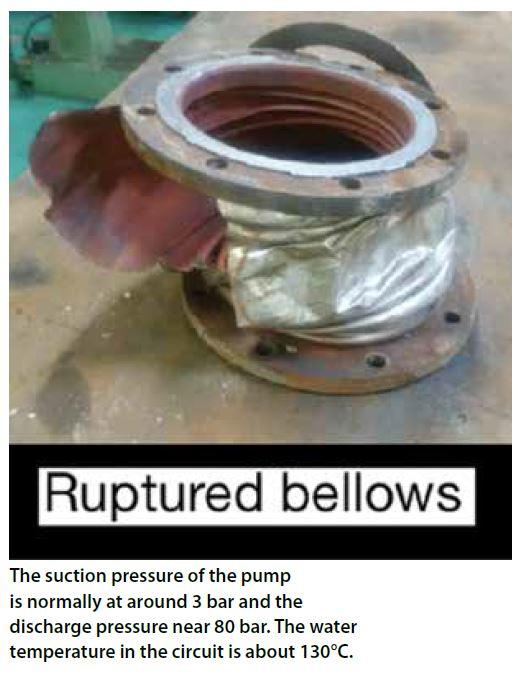201604 Hot water scalds three crew
The Chief Engineer planned some repairs of minor water and vapour leaks near the turbo pumps of the feed water circuit while the vessel was at anchor. The pump system consists of an expansion bellows, a suction valve, the pump itself and a discharge valve with non-return function.
There was no specific procedure for this work. Nonetheless, around 09.00 three engineers and two oilers under the supervision of the Chief Engineer started closing valves and opening drains. On turbo pump 2, the delivery valve was closed first by one of the oilers. Then the recirculation valve was closed. At 09.20, one of the engineers was standing on a ladder closing the suction valve when the expansion bellows ruptured. Hot water gushed over an engineer standing on the deck and to a lesser extent over the engineer on the ladder who had closed the valve. One of the oilers also received hot water on his ankles. All crew members were wearing full PPE, including helmets.
All three injured persons were immediately given first aid and were quickly evacuated by launch. One engineer was diagnosed with 1st and 2nd degree scalding injuries over his face and shoulders. The other engineer was diagnosed with 1st and 2nd degree burns over about 40% of his body (upper torso and face). The oiler had a large 2nd degree scalding injury on his left ankle.
The company investigation found that the rupture of the expansion bellows was caused by an overpressure in the pump system between the suction valve and the delivery valve. This overpressure was caused by a leak in the delivery valve; once the suction valve and recirculation valve were both closed the pressure quickly increased above the design pressure of the bellows, which is the weakest part of the system.
Normally the drain valves (and vent) must initially be cracked open to release the water and to provide confirmation that there is no pressure present in the system. In this case it was determined that the drain valves were probably left closed before the work started.
Findings of the company investigation
Performing this type of work with only ‘one-valve segregation’ appears to be a common working method, unchallenged throughout the industry. It is clear that this goes against the safety hierarchy of:
- Eliminating the hazard (shut down the boiler);
-Substituting the hazard;
- Isolating the hazard (two-valve segregation).
The design of the vessels means that using double valve segregation is often impossible for this kind of maintenance. Shutting down boilers is a time-consuming operation, which is not always supported due to commercial commitments or operational consequences such as cargo control. This is a topic that needs to be addressed industry-wide (for example, through SIGTTO).
According to the company investigation, the leadership style of the Chief Engineer probably contributed to the accident. He was directly involved in the work, giving short instructions rather than guidelines; he did not ensure closed-loop communication at every step. For example, one of the engineers thought that the Chief Engineer had opened the drains, but he was not certain. The crucial opening of the drains was left to assumption instead of positive confirmation.
The company also found the Chief Engineer’s safety awareness (and leadership) to be below standard. Among other things, there was no toolbox meeting or similar preparation just before the job began. A risk assessment of the work was created about 40 minutes after the accident had occurred.
To the Chief Engineer’s credit, his insistence on the use of full PPE, and helmets in particular, largely contributed to reduction of consequences to the engineer whose head and face were exposed to the hot water.
Other lessons learned
Instead of working in an ad hoc manner based on the experience of the particular persons on site, procedures should always be developed, and followed, for any work that involves risks that are not acceptable. Procedures should bring risks to the level of as low as reasonably practicable (ALARP).
Editor’s note: In order for safety to ‘get done’ it is crucial for shipboard leaders to exhibit strong safety leadership. This does not necessarily mean taking dictatorial control of a situation. By opening up communications and listening to workers, as well as ensuring procedures are developed to safeguard against all identified risks, leaders and crew will reap the benefits of increased safety.

